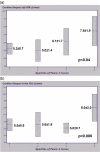Metabolomic profiling reveals distinct patterns of myocardial substrate use in humans with coronary artery disease or left ventricular dysfunction during surgical ischemia/reperfusion
- PMID: 19307475
- PMCID: PMC2756963
- DOI: 10.1161/CIRCULATIONAHA.108.816116
Metabolomic profiling reveals distinct patterns of myocardial substrate use in humans with coronary artery disease or left ventricular dysfunction during surgical ischemia/reperfusion
Abstract
Background: Human myocardial metabolism has been incompletely characterized in the setting of surgical cardioplegic arrest and ischemia/reperfusion. Furthermore, the effect of preexisting ventricular state on ischemia-induced metabolic derangements has not been established.
Methods and results: We applied a mass spectrometry-based platform to profile 63 intermediary metabolites in serial paired peripheral arterial and coronary sinus blood effluents obtained from 37 patients undergoing cardiac surgery, stratified by presence of coronary artery disease and left ventricular dysfunction. The myocardium was a net user of a number of fuel substrates before ischemia, with significant differences between patients with and without coronary artery disease. After reperfusion, significantly lower extraction ratios of most substrates were found, as well as significant release of 2 specific acylcarnitine species, acetylcarnitine and 3-hydroxybutyryl-carnitine. These changes were especially evident in patients with impaired ventricular function, who exhibited profound limitations in extraction of all forms of metabolic fuels. Principal component analysis highlighted several metabolic groupings as potentially important in the postoperative clinical course.
Conclusions: The preexisting ventricular state is associated with significant differences in myocardial fuel uptake at baseline and after ischemia/reperfusion. The dysfunctional ventricle is characterized by global suppression of metabolic fuel uptake and limited myocardial metabolic reserve and flexibility after global ischemia/reperfusion stress in the setting of cardiac surgery. Altered metabolic profiles after ischemia/reperfusion are associated with postoperative hemodynamic course and suggest a role for perioperative metabolic monitoring and targeted optimization in cardiac surgical patients.
Figures





Comment in
-
Metabolomic profiling of cardiac substrate utilization: fanning the flames of systems biology?Circulation. 2009 Apr 7;119(13):1700-2. doi: 10.1161/CIRCULATIONAHA.109.849919. Circulation. 2009. PMID: 19349333 No abstract available.
References
-
- Sabatine MS, Liu E, Morrow DA, Heller E, McCarroll R, Wiegand R, Berriz GF, Roth FP, Gerszten RE. Metabolomic identification of novel biomarkers of myocardial ischemia. Circulation. 2005;112:3868–3875. - PubMed
-
- Mayr M, Yusuf S, Weir G, Chung YL, Mayr U, Yin X, Ladroue C, Madhu B, Roberts N, De Souza A, Fredericks S, Stubbs M, Griffiths JR, Jahangiri M, Xu Q, Camm AJ. Combined metabolomic and proteomic analysis of human atrial fibrillation. Journal of the American College of Cardiology. 2008;51:585–594. - PubMed
-
- Neubauer S. The failing heart--an engine out of fuel. The New England Journal of Medicine. 2007;356:1140–1151. - PubMed
-
- An J, Muoio DM, Shiota M, Fujimoto Y, Cline GW, Shulman GI, Koves TR, Stevens R, Millington D, Newgard CB. Hepatic expression of malonyl-CoA decarboxylase reverses muscle, liver and whole-animal insulin resistance. Nature Medicine. 2004;10:268–274. - PubMed
Publication types
MeSH terms
Substances
Grants and funding
LinkOut - more resources
Full Text Sources
Other Literature Sources
Medical

